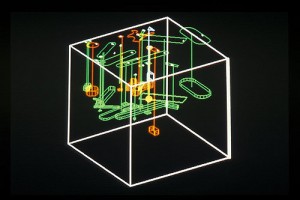In hydraulic systems, oil from a tank is stored in an oil tank from where it is pumped to move pistons. A filter is typically installed at the suction of the pump in order to filter out any impurities. The pump, usually a gear type or positive displacement pump, is usually driven by an electric motor (less often by an air motor).
How hydraulic systems work
The pump boosts up the oil pressure. Most hydraulic systems are equipped with a mechanism for preventing overpressure. One such method involves returning the pumped hydraulic oil to the oil tank. The pressure control box shown on the sketch below is typically a relief valve, through which, oil returns to the tank in case of overpressure.
Pumped oil at high pressure flows through a control valve (see directional control box). The control valve can change the direction of oil flow, depending upon the desired action on the load. The load can be shifted to the left or to the right (see figure-1) by changing the side of the piston where the oil pressure is exerted. The oil entering the cylinder applies pressure on the piston, thereby developing a force on the piston rod. The force on the piston rod enables the movement of the load. The oil from the other side of the piston returns to the oil tank.
Figure 1 - Typical hydraulic system layout
Mathematical equation for hydraulic pistons
The relationship between pressure and force exerted on a hydraulic piston is expressed through the following straight-forward mathematical equation:
Force (F) =Pressure (P) x Cross section area of piston (A)
Safety considerations for hydraulic systems
Any use of a pressurized medium can be potentially hazardous. Hydraulic systems carry all the risks of pressurized systems. Protective devices against overpressure (most common ones are relief valves and hydraulic accumulators) must always be installed.
Critical installations, like for example hydraulic oil systems of gas-steam turbines lubrication systems, typically require the installation of redundant equipment, i.e. 2*100% hydraulic pumps.
When using oil as a fluid in a high pressure hydraulic system, the possibility of fire or explosion is present. A severe fire hazard can occur if the high pressure piping leaks and oil is allowed to vaporize into the atmosphere. Extra precautions for fire protection shall be taken wherever the risk of piping rupture or leakage is high. If oil is pressurized by compressed air, a potential explosive hazard exists if the high pressure air comes in contact with the oil. A rigorously followed preventive maintenance and health and safety plan is the best protection against such hazards.
Frequent applications of hydraulic systems
Hydraulic systems are used widely, in hydraulic brakes in cars and other vehicles, heavy-duty type machinery like bulldozers cranes, and fork lifts, aircrafts (use of hydraulic mechanism for the deployment of landing gear) and submarines (hydraulic systems used for operation of torpedo tubes and other critical functions) are only just a few of practical examples of use of hydraulic systems.





